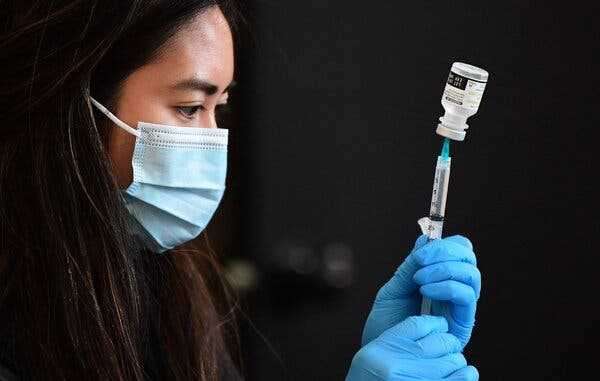BA.5 is now dominant in the United States, and the White House, which has been watching it march across Europe and South Africa, is scheduled to outline its strategy against it.
-
Send any friend a story
As a subscriber, you have “>10 gift articles to give each month. Anyone can read what you share.
Give this article
- Read in app
This article is part of our Coronavirus Updates

Preparing a coronavirus vaccine dose in January. A U.S. official said that getting a booster now would not preclude people from getting another one reformulated to combat Omicron later.
President Biden’s coronavirus response team is planning to warn Americans on Tuesday that they must do more to protect themselves against Covid-19, as the highly transmissible BA.5 subvariant of the coronavirus fuels a new wave of infections, re-infections and hospitalizations across the country.
BA.5, an offshoot of the Omicron variant, is now dominant in the United States. The White House has been watching it march across Europe and South Africa, and on Tuesday, the response team is scheduled to outline its strategy to combat the subvariant, which appears to be able to evade vaccines, as well as immune system defenses built up through prior infection.
“The key feature of BA.5, that we know about, is its immune evasiveness — you can be fully vaccinated and boosted and still have a risk of a breakthrough infection,” Dr. Ashish K. Jha, Mr. Biden’s coronavirus response coordinator, said in an interview Monday. “You can be previously infected — even as recent as the last couple of months — and have a very high rate of reinfection.”
As part of the strategy to combat BA.5, federal officials are considering expanding eligibility for second coronavirus booster shots to adults under 50, according to several people familiar with the thinking. Beyond that, the plans do not sound very different than those to combat previous Omicron subvariants.
A White House fact sheet said the administration would continue to advise Americans, particularly those age 50 and older and those who are vulnerable, to get booster shots; to test if they show symptoms; and to seek out therapies, including Paxlovid, which has been shown to reduce the risk of hospitalization and death, if they get sick.
As Americans have turned their attention away from the pandemic, mask mandates have dropped and people are going about their daily lives, often regarding Covid as more of a nuisance than a threat. But experts warn that the pandemic is far from over, even if it has receded from Americans’ daily consciousness.
The daily number of reported cases in the United States has remained steady at roughly 100,000 — a figure that many experts say is underreported because so many people are testing at home. But hospitalizations have risen 18 percent over the past two weeks, according to a New York Times database.
United States Covid-19 Hospitalizations New reported cases by day All timeLast 90 days Feb. 2020 Jul. Dec. May 2021 Oct. Mar. 2022 50,000 100,000 150,000 hospitalized 7–day average 37,766 Source: U.S. Department of Health and Human Services. The seven-day average is the average of a day and the previous six days of data. Currently hospitalized is the most recent number of patients with Covid-19 reported by hospitals in the state for the four days prior. Dips and spikes could be due to inconsistent reporting by hospitals. Hospitalization numbers early in the pandemic are undercounts due to incomplete reporting by hospitals to the federal government.
Dr. Jha said that figure could reflect those who are hospitalized for medical issues other than Covid, but who test positive. But some other experts have said that the increase in hospitalizations indicates that a BA.5 surge is already underway.
“We’re in a surge,” said Dr. Eric Topol, a cardiologist and director of the Scripps Research Translational Institute. Referring to the early days of the first Omicron surge, he added: “It won’t be as bad as what we went through in January. But it isn’t good. And we basically have let down our guard.”
In a recent post on Substack, Dr. Topol called BA.5 “the worst version of the virus that we’ve seen.”
Currently, a national average of about 330 coronavirus deaths are reported each day, according to The Times’s database, down from more than 2,600 a day at the height of the Omicron surge. But if the 330 average remained steady over a year, it would amount to more than 120,000 deaths — a figure Dr. Jha called “unacceptable.” By comparison, the Centers for Disease Control and Prevention estimates influenza claimed 12,000 to 52,000 lives in the United States annually from 2010 to 2020.
Since April, when Dr. Jha replaced Jeffrey D. Zients as the coronavirus response coordinator, the White House’s Covid briefings have been fewer and farther between. The last briefing was nearly three weeks ago. Dr. Jha will be joined on Tuesday by Dr. Anthony S. Fauci, Mr. Biden’s top adviser for the pandemic — who last month was recovering from his own bout with Covid — and Dr. Rochelle P. Walensky, the C.D.C. director.
Looking ahead, Dr. Jha said that getting a booster dose now would not preclude people from getting another booster, reformulated to combat Omicron and its subvariants, in the fall. Last month, an expert committee recommended that the Food and Drug Administration move to update booster shots to target different forms of Omicron.
But those doses may not become available until October, Dr. Jha said. And even then, the administration may not have enough booster shots for every American who wants one, because Congress has refused to allocate any additional pandemic aid. In the event of a shortage, he said, the administration would prioritize older Americans and those with specific vulnerabilities.
“My hope is that is not a decision that we need to make,” Dr. Jha said. “But it will get harder and harder to have vaccines in time, the longer Congress waits.”
Source: nytimes.com



